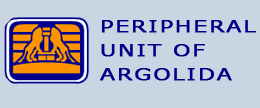Tiryns / (Monument of World Heritage UNESCO)
|
Historical background The low hill of Tirynth, in the 8th kilometer of road Argos-Nafplio, was continuously inhabited from the Neolithic Age to Late Antiquity. In prehistoric times, the area flourished mainly during the early and late Bronze Age. In the second phase of the EH era (2700-2200 BC) a major centre with dense population and a unique construction circular building, 27 meters in diameter, must have been here on top of the hill. |
||
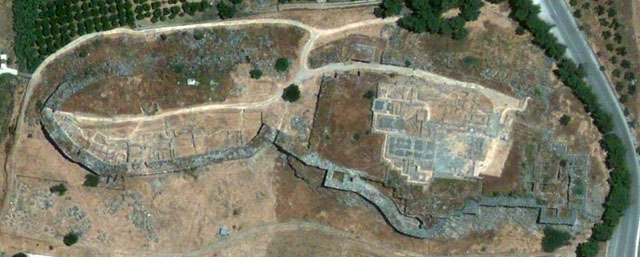 |
||
| Aerial view of the site | ||
|
During the Late Bronze Age, Tiryns fortified hill gradually and surrounds within the "Cyclopean" walls of the palace complex and other buildings used primarily by the ruling class as places of worship, warehouses and workshops as well as residences. In historical times, Tiryns, although it should have been in the form of an organized political community, could not compete with Argos, which destroyed it, in the first half of the 5th century, exiling its inhabitants. Pausanias, who visited Tiryns the 2nd century AD, found it deserted. During the Byzantine era in Upper Acropolis a funerary temple was founded and possibly a small class settlement in the west of the Acropolis. The end of the small longer settlement must be connected with the conquest of Argos from the Turks in 1379 AD. In Venetian sources, Tirynth was referred to as Napoli vecchio, while the name Tirynth was given again in the modern era replacing the usual name "Paleocastro.(old castle)". |
||
 |
||
| View of south-west walls |
||
|
The investigations of the German Archaeological Institute and the Greek Archaeological Service from 1876 to present times, have unearthed major Mycenaean citadels, tracking stages of the culture of prehistoric and historic periods of Argolida prefecture. After the pioneers Heinrich Schliemann and Wilhelm Dorpfeld (1884-1885), the area was investigated in the first half of the twentieth century, by Georg Karo and Kurt Müller.
In the late 1950s, the Curator of Antiquities of Argolidos, Verdelis Nikolaos, undertook the restoration project on the west side of the fortifications which had collapsed and covered by the debris of old excavations. After 1967, the excavations conferred again in German Archaeological Institute, under the supervision of Ulf Jantzen, Jörg Schofer, Klaus Kilian and Joseph Maran continual research, including the Lower Citadel and the Lower City. At the same time, excavations are undertaken by the local Conservation Unity of Antiquity both at visited archaeological sites and regions. |
||
 |
||
| View from the eastern fortifications of Tiryns | ||
|
The discovery of the excavations of a monument protected for centuries under the soil and long-term exposure without maintenance care to weather conditions and the actions of visitors caused significant damage to the archaeological site. Through actions of D Conservation Unit of Prehistoric and Classical Antiquity Items, competent service of the Ministry of Culture and the direct support of the Peloponnesian Region, the monument were included in projects funded by the Second and Third Community Support Framework. |
||
|
The participation of the German Archaeological Institute which funded the last decade studies of German architect Jan Martin Klessing implemented in Tirynth, was funded. During this time, a large number of collaborators (archaeologists, designers, skilled and unskilled workers) participated in the program of upgrading one of the most important archaeological sites of the Argolida which is included in the list of monuments of world heritage of Unesco. Besides the responsibility of the Directorate of Restoration of Ancient Monuments, Ministry of Culture implemented modelling works for the archaeological site, open to visit, which now includes organized routes, buildings convenience, new entrance and parking. |
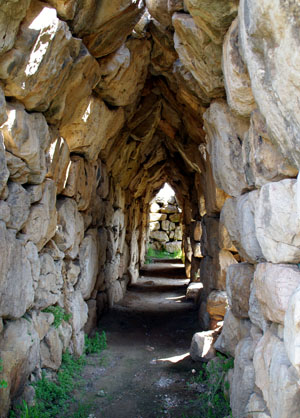 View of the tunnel |
|
The Monuments of Area Western Bastion The Western Bastion is an outstanding achievement of Mycenaean architecture with a clear defensive character. The western staircase is protected by a bastion creating a sickle extension of the wall of the third phase. This section of the wall is the only one with curved outline. The maximum width is 7 m the curved section of the wall begins in the south at the height of the large yard and ends at the north tower which existed already in the second phase of the wall. |
||
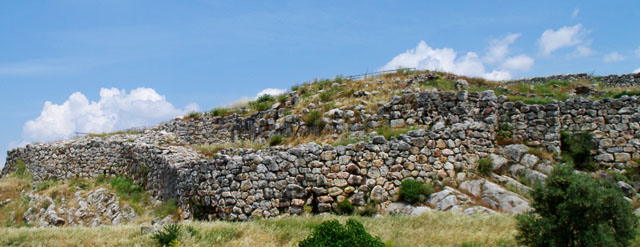 |
||
| View of West Bastian |
||
|
Fortification of Tirynth
The walls bounding the citadel of Tirynth were built in three main construction phases and fortified gradually whole hill from the south-highest to lowest north-sixes. Red and gray limestone found abundant both on the same hill as the hill of Prophet Elias east of the citadel were used as a building material. The size of the boulders which were mainly used for the walls of the third phase caused wonder and admiration to antiquity, which is directly reflected in the myth of the Cyclops. The boulders weigh several tonnes justifying the view of Pausanias (II, 25, 7-9) that neither pair of mules was able to move the smallest of them. |
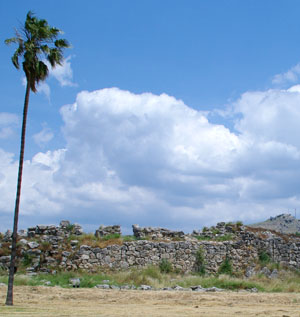 View of Fortification |
|
|
Lower Acropolis On the north and lowest elevation of the hill of Tirynth, the Lower Acropolis was fortified for the first time in the early 13th century BC (HR IIIV1). The fortification was replaced in the third phase of construction of the wall in the 13th century (Late Helladic IIIB2) by a strong wall thickness up to 7 m below the natural contours of the hill and extending south to the intersection with the fortification of the Middle and Upper Acropolis. The Lower Acropolis connected through northern extension of the runway (50) with the Upper Citadel, but it also has two of its own access. A small entrance at the bend of the western side of the wall between the middle and lower citadel which was closed with a gate as traces of the hinges on the monolith threshold evidenced, and an opening in the top of the north wall untracked for a door. This opening is protected by a guardhouse on the eastern side of the wall which was much higher than the external level and the access to it must have been made possible with portable wooden scale. On the contrary, the entrance on the west side leads to an open stone staircase. In the second half of the 13th century BC (Late Helladic IIIB2) after the completion of the fortifications, a huge construction activity grows, destroying the interference of the remains of earlier Mycenaean periods and Middle Helladic. The lower acropolis is formed into terraces and is built with a single plan. The buildings lined up along the walls are separated from the open walkways running north-south. A main road leads from the north gate to the south of Lower Acropolis and is associated with the runway (50) leading to the Upper Citadel. Overall, ten building complexes were investigated (buildings I-X), which served as homes and also as laboratory facilities for the processing of metals and precious materials. Similar use is witnessed for rooms inside the wall. |
||
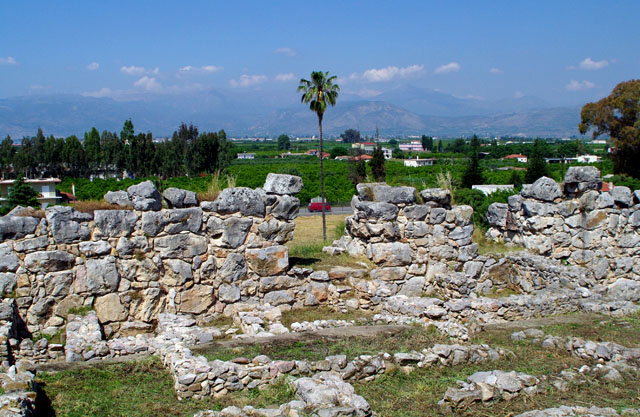 |
||
| View of small section of Lower Acropolis |
||
|
Geometric Church
East of the gate that connects the courtyard 30 with the courtyard of the building 29 of the east wing of the palace, a pit – depositor was investigated in 1926, the so-called cesspit, which contained mainly pottery and a few metal objects. The oldest finds date back to the Late Geometric period and the newer around 650 BC, despite the fact that the majority of the offerings belong chronologically to the end of the geometric and sub-Geometric period. The quality of the findings, include the clay shields and masks which are displayed in Museum of Nafplio, and their preservation, where most findings are crushed before disposal and bear traces of secondary combustion, arguing for its status as tributes. It is very probable that some of them were hung in a sacred space while others served for rituals probably at an altar space. The finding of the cesspit was associated for these reasons with the retrofit of the altar at the high court and with the elongated building that covers the eastern part of the great palace of the Mycenaean era. So, it was considered that this building was a temple of the Geometric period, established at the Mycenaean Palace where people worshipped the goddess Hera. Unfortunately, the full revelation of this building ever since Schliemann period has deprived research from valuable archaeological evidence that could give a definitive answer to the still open question of the use and the dating of the building. |
||
| Dr. Alkistis Papadimitriou Head of D Conservation Unity of Prehistoric and Classical Antiquitiy |
||
|
More information about the archaeological site of Tiryns can be found on website of the Ministry of Culture and Tourism ODYSSEUS |
||
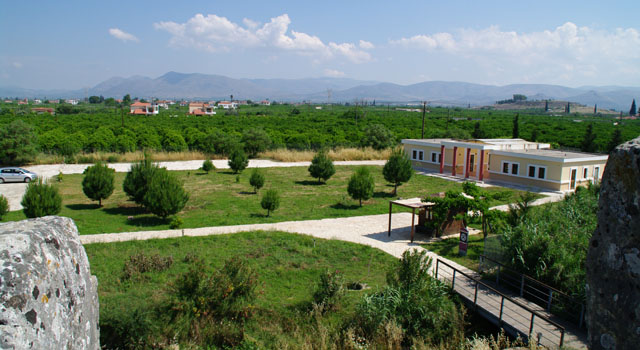 |
||
| View of the entrance of the Archeological Site |
||
Address: Tirynth in Argolida (Lat: 37.60092972973225, Long: 22.799039483041156) The exact location of the Archaeological Area can also be tracked in Section Map
Opening hours for the Archaeological Site Monday - Sunday 8:00 to 20:00 |
||


